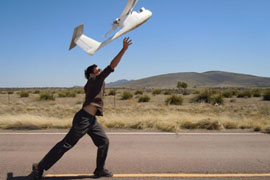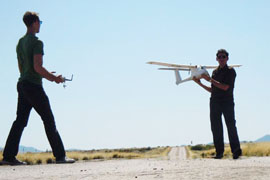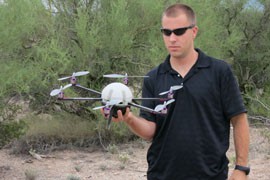Cronkite News has moved to a new home at cronkitenews.azpbs.org. Use this site to search archives from 2011 to May 2015. You can search the new site for current stories.
UAV degree: Colleges offer courses in drone design, marketing
Editor’s Note: Second in a three-part series.
WASHINGTON – Stephen Rayleigh and Matt Lyon thought they were done with careers in drones after they left the Army in 2010 and enrolled at Embry-Riddle Aeronautical University in Prescott.
Until they met Professor Ray Bedard.
Rayleigh wanted to start a club that would build and fly drones; Bedard had wanted for years to launch drone classes. The club became a class in 2011, with the help of Lyon and Rayleigh’s expertise, and the class grew into a full-fledged drone minor that attracted 28 students when it launched at the school in August.
The minor aims to prepare students to build and fly unmanned aerial vehicles – UAVs, or drones – for a commercial market that doesn’t yet exist.
That has not stopped colleges from jumping in to the field to produce workers for an industry that many believe is poised to boom.
“Once the FAA (Federal Aviation Administration) opens up the sky, there is going to be an incredible demand,” for professionals in the drone business, Bedard said.
In Arizona alone, Embry-Riddle and Cochise College have launched drone programs, Arizona State University is developing a minor and one for-profit school is offering courses online. Schools in other states are already offering similar programs, with Bedard’s minor modeled after a large-drone program at the Embry-Riddle campus in Daytona Beach, Fla.
Unmanned aircraft systems and related industries are already well-established in Arizona, employing an estimated 42,000 people in 2010, according to an Arizona Commerce Authority report, mostly in defense-related businesses.
The Association for Unmanned Vehicle Systems International predicts the industry could create 70,000 new jobs within three years of the release of FAA regulations, which should allow the commercial side of the business to take off. It predicted that as many as 3,000 of those jobs could be in Arizona, fifth-most in the nation.
“Commercial use of UAVs is going to continue at marginally the same rate as it has in the defense industry, which is double, double, double” said Matt Pobloske, a business development director in Tucson for BAE Systems.
Pobloske said BAE, a defense contractor, is already producing drones for geoscience and atmospheric research applications and for use by public institutions, and hopes to move into the wider commercial market in the future.
Future is the operative word, as there are numerous challenges facing the development of a commercial drone industry.
In addition to a perception problem – to many, “drone” conjures the image of weapons-carrying military aircraft that hunt terrorists overseas – concerns about spying drones have sparked legislation at the state and federal level.
And as Bedard noted, the FAA has yet to write standards for commercial use of drones, which is currently prohibited by the agency in most cases. Public institutions, like the U.S. Forest Service, can get permission to fly drones for civilian uses and others can fly small drones under rules established for radio-controlled model plane hobbyists.
Those rules limit the size of drones, which have to fly below 400 feet, within sight of the operator and not near an airport. That puts a crimp in entrepreneurial aspirations for the industry.
“A big reason we’re not going to blow up in the first year is we don’t want to break the law,” said Rayleigh, who now hopes to get into the drone business.
Because of FAA restrictions, Embry-Riddle cannot require students to fly drones as part of their studies, so some students participate in the club, which operates under the FAA hobbyist laws.
The club designed a 10-pound aircraft and developed software that allows it to autonomously identify specific targets for competitions. The aircraft can also be directed through a point-and-click interface on a laptop or tablet.
“Touch on the map where you would like the UAV to fly and it flies there,” Rayleigh said.
He said he runs the club “as if it was a UAV business,” and takes every precaution when the team practices for competition. Team members keep an eye out for weather that might hurt their drone and keep it in sight at all times so they can turn off the autopilot at the first sign of malfunction.
Lyon said the vast majority of students in the minor are “just curious.” The program attracted students in majors as varied as business, engineering and global security and intelligence studies.
Bedard said that as they designed the minor, he asked: “What would the students need if they were going to start a business? … Because I think that’s the future.”
It’s a definite change of pace for Lyon and Rayleigh, who learned to fly drones at Fort Huachuca and went on to fly missions with 375-pound drones – about mid-size – in the Middle East.
The two hope to ultimately start a surveying business for real estate, forestry, mining and other fields that require images newer and at a higher resolution than can be had from something like Google Earth.
At Cochise College, Don Wirthlin has his students focused on civil applications for agriculture, on search and rescue, on finding hotspots in forest fires or analyzing heat loss from buildings. He gets frustrated by widespread misunderstanding of the commercial drone industry generated by the negative publicity of military drones.
“There’s a lot of positives that people just don’t understand,” said Wirthlin, a former trainer at Fort Huachuca.
He said Cochise College has been considering a UAV program for 10 years. It finally started in January with the first group of six students.
The school set up simulators for the first lab class in April. All students in the Cochise program are required to be certified pilots so they have a foundational knowledge of flight and better spatial awareness of the plane’s movement than someone who has never flown a plane.
Wirthlin said Cochise College hopes the unmanned program will eventually grow as large as its manned aircraft-training program, which currently has 55 students enrolled.
“We’re developing a UAV program because jobs are hard to get and we’re on the front edge of it,” he said.









